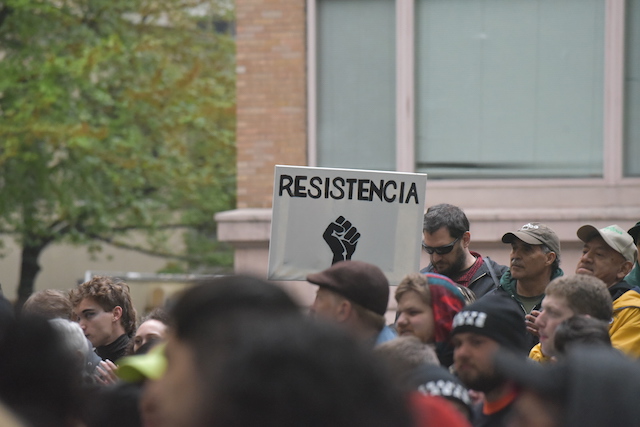
Photo by Pete Shaw
Story by Pete Shaw
Approaching Shemanski Park, once again the sight of Portland’s May Day rally, I had the feeling there would be trouble with the police. I ran into a Friend across the street from the park. It was not yet noon, but a large crowd had already gathered for the 2 PM rally and subsequent permitted march. The mood was peaceful, but vibrant. As we stood talking, a contingent of five or six police on motorcycles passed by. Not long later, while I was in the park, a couple of platoons of bicycle police rolled past. By 1 PM, still an hour before the rally was scheduled to begin, small clutches of three or four police had walked through the park a few times, telling people their signs could not be used in the parade because the poles upon which they were mounted were to be prohibited during the march as they could be used as weapons. I had not seen police insist upon these conditions for the recent Climate and Women’s marches. By the time the rally began, numerous police, including many in riot gear, were milling about the perimeter of the park. For over two hours, they made their presence known–while willfully ignoring the event’s police liaisons–and it seemed like they were looking for trouble.
May Day 2015 was plagued by police intervention and intimidation. In particular, when after the march had ended and people were milling about Pioneer Square, the police announcement vehicle passed by along with a number of bicycle police. I recall the police announcing that Pioneer Square had to be cleared, despite the scene there being peaceful. It reeked of antagonism, and they got more than the bargained for. They were soon surrounded by people who had taken part in the march and were in no mood for another police power trip. Another group of bicycle cops showed up, as did some riot cops. Police used pepper spray to extricate their fellow officers. They and the riot cops were eventually driven off, and as the riot cops fled on truck, they recklessly shot pepper spray at people and fired off flash-bang grenades.
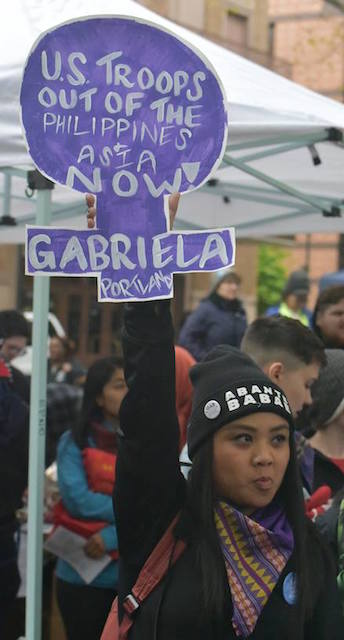
Photo by Pete Shaw
Perhaps that memory, as well as the marches in the days following the November elections, was informing this overt attempt to show who was in charge on Monday. For what other reason but to intimidate would so many police–many fully militarized with riot gear and weapons–surround the people in Shemanski Park? Parade organizers did not desire their presence, and they were not needed. In a park where there were numerous organizations directed by and composed of people of color and immigrants, the sight of members of a police force whose officers are rarely held accountable for their brutalization and murder of people of color struck me as unwelcome.
The rally was fantastic, and I think it is important to acknowledge the work of the nearly 50 groups involved in planning the event. In particular, the All-African People’s Revolutionary Party, which organized last year’s May Day rally, deserves great credit. Last year’s May Day saw the glaring absence of a march, which struck a bad nerve with some people. It was a fair enough criticism: I love the May Day march. It’s a highlight of my year. But when it was announced that there would be no parade, I sloughed it off to people who understood things better than I making that decision. Which as usual turned out to be true. The focus of the day was on organizing, on working to get people on the sidelines involved in organizing for justice and against capitalism, colonialism, and imperialism, and on fostering solidarity between organizations. It was a great event, and if it lacked the spectacle of a parade, it made important gains that were apparent at this year’s rally.
This May Day, there was electricity in the air. Some of this was no doubt due to the strange times in which we find ourselves. But it also felt that there were more organizations with greater involvement in their ranks, and the feeling that these many groups understand how powerful they were when they worked with each other was palpable. My Friend Roben White delivered an eloquent and moving opening prayer, and later closed out the rally with a dash of fire and brimstone, urging people to organize their workplaces. A good person speaking good words to good people.
In between, there were other powerful speakers and great artists as well, their messages relayed in English, Spanish, and Sign. Everyone who spoke had something to say about their community, its approach to resistance, and their connection to the struggle for a more just world. I usually find these parts of rallies a bit tedious, as if space is just being filled to make sure everyone gets a turn. It can suck the life out of an event. But on May Day each of those voices, while speaking about struggles for justice, was talking about the specific experiences of a particular community organizing for action. Each had come down from some place on the mountain, dispensing their Wisdom to the gathered. It was fresh, and it put a crackle in the air.
Amen.
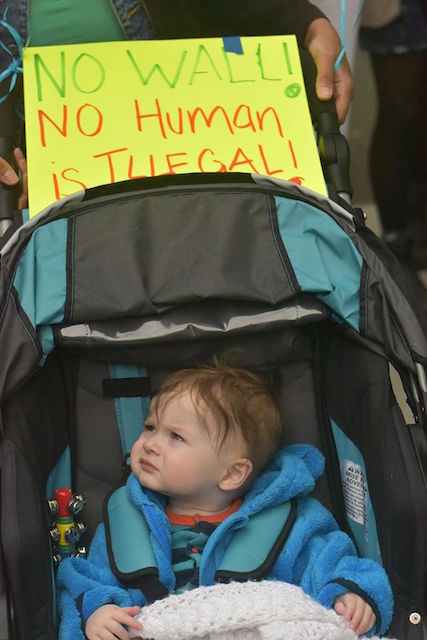
Photo by Pete Shaw
My Friend Cager, a Longshoreman across the river in Vancouver, greeted me at this time, and as ever, it was great seeing him. As I turned around to embrace him, I saw that the crowd had gotten much larger. It was in its way a poetic moment, the bond of Friendship within the bonds of Camaraderie.
The march began a little after 3 PM. Things were going smoothly even as the march was surrounded by police. People were together, marching for justice. Then, at some point, things got weird.
A Friend and I were marching along 2nd Avenue, I think, when–after seeing a contingent of riot cops barricade the Morrison Bridge–we heard the police announcement vehicle playing a message, but we could not discern the words. It later became known that the police had canceled the march because a few people, putatively some of the anarchists who are sometimes referred to as Black Bloc (even as, I think, this is a tactic, not a group), broke some windows at Target, and threw cans of Pepsi at the police (a reference to the commercial from about a month ago in which some person defuses tension between cops and protesters by offering a can of that health hazard to a police officer).
When I finally could hear the police announcement, it was one that threatened violence. I was standing near the corner of 3rd and Alder. A block away in the intersection of 3rd and Morrison, I could see thick smoke rising from a large traffic control device and some other objects that had been set on fire.
The riot cop trucks had for some time had been following the rear of the march, continuing the intimidation tactics they had been deploying all day. A small army of armored police with sticks, guns, and whatever other military gear they were carrying leapt from the trucks on to 3rd Avenue. By the time they got down to the serious business of firing weapons at marchers, they had–contrary to many reports–long been antagonizing the May Day crowd.
Maybe 20 feet away from me when I was at 3rd and Alder, a couple of riot police shot some flash-bang grenades that exploded some three of four stories in the air above the intersection of 3rd and Morrison. They marched up the streets wielding long batons. People said they fired rubber bullets and tear gas. Before long, when I found myself paralleling the riot police as they marched up Morrison, I would guess I had counted at least 50 police in riot gear, on foot and truck, conducting their obscene parade.
Those flash-bang grenades exploded above the parade of over 1,200 peaceful people that included children and people with disabilities. I was about 30 feet from where one exploded two years ago, and it was the loudest thing I have ever heard, enough that I felt like someone had hit me in the head. Police clad in riot gear marched toward those children and their guardians, nearly all of whom had been marching peacefully, many of whom were seeking safety from the police.
People fled, terrorized.
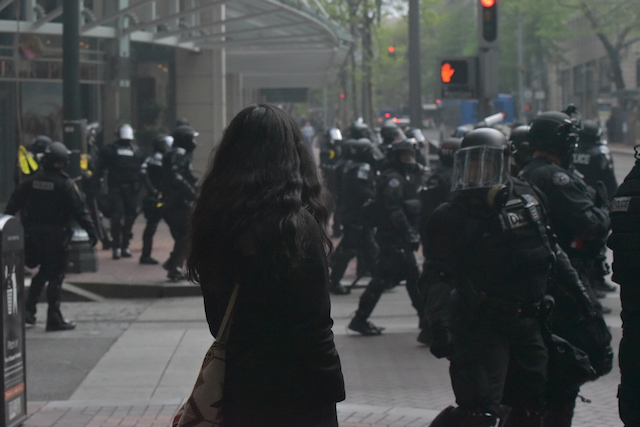
Photo by Pete Shaw
Some comments from immigrants, and from parents who were caught in the conflict with their children, noted that the anarchists, once the police shut down the march, gave them the time to escape from the police kettle. Clearly these voices do not represent everyone, but I have not seen that version of events reported in the corporate media.
For one angle, here is a portion of a statement issued by the Portland May Day Coalition:
Today the Portland police chose to violently escalate a peaceful march.
The people asserted their (lawful) right to be in the street and express
solidarity with immigrants, with workers, with Indigenous sovereignty,
and against capitalism…There will be a lot of articles about “the march
turning violent” but make no mistake, the PPB attacked a permitted march
whose only goal was to keep moving along its planned route because
some noisemakers and name-calling were enough of an excuse for them
to use their large surplus of explosives and chemical weapons against
those who had committed to rise, resist, and unite, against fascism and
Capitalism.
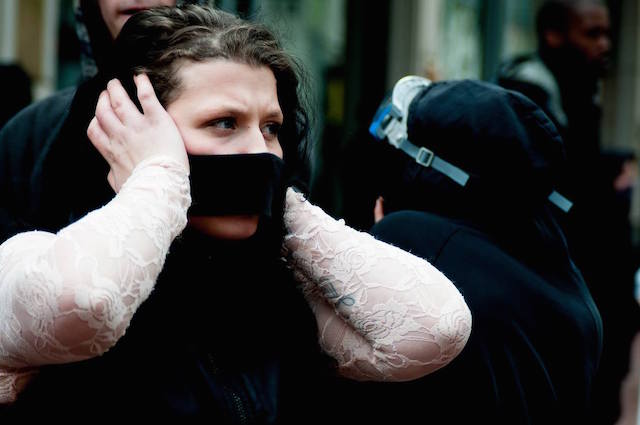
Photo by Bette Lee
Bette Lee, whose photos grace this article, had this to say:
The march started off peacefully, and from my observations, the “riot”
began when the riot cops arrived. Like so many protests and marches
I’ve been to over the years, it’s the cops who escalate and turn
non-violent protests into another spectacle of violence…Sure, the
Black Bloc protesters threw water bottles, cans of soda, and set off
smoke bombs, even broke some windows of corporate retail stores. Is
that all it takes to make the cops go ape-shit? Just look at the shit that
went down in other cities around the world. This was pretty tame by
comparison. The presence of the riot cops, their violent behavior (I
saw them kick the shit out of someone who was just walking “too
slowly” in front them) and those horrible stun grenades that they fired
were much more terrifying to me and others. It’s the intimidating and
violent actions of the police that are the problem
We should not be spending our time condemning the actions of a handful of anarchists. Far more important for current discussion is the over-the-top response of the police and how we can better organize people in opposition to them. Let’s be clear: the Portland Police started a riot and conducted a violent wholesale attack upon innocent people. Online, there is a large contingent of people talking about how people need to take responsibility for their actions, and that is correct. But their words are being aimed only at the handful of people who threw objects at police, broke windows, and later set some things on fire.
However, that same standard of taking responsibility for one’s actions must also be applied to the police. And it must be applied far more rigorously than to these window breakers because of the inordinate amount of power police wield, particularly when they are militarized. They could have sent some officers into the group of anarchists and arrested some people then and there. But instead they went for collective punishment, attacking everyone in the march.
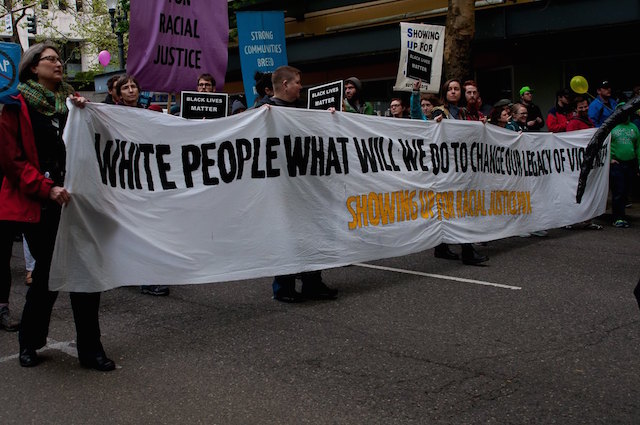
Photo by Bette Lee
“Some may try to point to groups of people in black hoodies as the source of the problem,” wrote Kari Koch of Showing Up for Racial Justice (SURJ) in a personal Facebook post, “but police are entirely responsible for the fear and violence on May Day. No amount of thrown Pepsi cans or broken windows could ever justify the use of chemical weapons and explosives, especially not when children and vulnerable people are near.”
Koch was not alone in her assessment and condemnation of the police. Numerous groups involved in the rally and march echoed her sentiments that the police were responsible for the violence in Portland’s streets. It is heartening to see the solidarity among these groups as they refuse to be intimidated by the police.
May Day is traditionally a day celebrating working people and the gains they have made against a capitalist system and a ruling class that willingly and willfully uses police to enforce its interests of profits over people. Through the years the day has also included calls for immigrant justice, and as well more recently has featured louder demands for solidarity against the colonialism and imperialism at the heart of capitalism, and their attendant bigotries. Many people have died for these struggles, and the gains that have come as a result of them.
Consistent through all this has been the use of police to oppose, often violently, these aspirations for justice. The interests they serve and protect are not ours.







1 comment for “May Day”